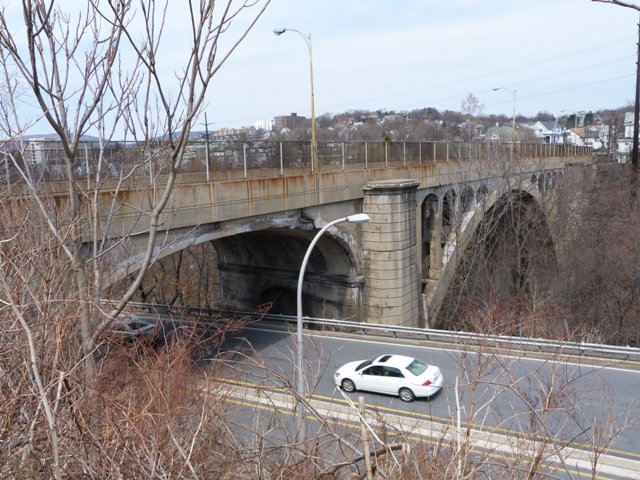We Recommend:
Bach Steel - Experts at historic truss bridge restoration.
BridgeHunter.com Phase 1 is released to the public! - Visit Now
Harrison Avenue Bridge

Primary Photographer(s): Nathan Holth and Rick McOmber
Bridge Documented: April 15, 2011
Harrison Avenue (PA-6011) Over Roaring Brook, PA-6011, and Railroad
Scranton: Lackawanna County, Pennsylvania: United States
Concrete Closed Spandrel Deck Arch, Fixed and Approach Spans: Concrete Deck Arch, Fixed
1922 By Builder/Contractor: Anthracite Bridge Company and Engineer/Design: A. Burton Cohen of New York, New York
Not Available or Not Applicable
202.0 Feet (61.6 Meters)
392.0 Feet (119.5 Meters)
30 Feet (9.14 Meters)
1 Main Span(s) and 2 Approach Span(s)
35601101900452

View Information About HSR Ratings
Bridge Documentation
This bridge no longer exists!
Bridge Status: Demolished May 2018.View Archived National Bridge Inventory Report - Has Additional Details and Evaluation
View Historic American Engineering Record (HAER) Documentation For This Bridge
View Original Plans For This Bridge
View PennDOT Rehabilitation Feasibility Analysis
View PennDOT Determination of Effects Report
This bridge is a beautiful concrete arch bridge with a large open spandrel main span flanked by a single closed spandrel arch at each end. The bridge's piers once had pillars that rose above the deck for decorative purpose but those were removed in years past. Despite alteration above the deck, the arch below the deck retains its original design and is handsomely composed, a very attractive structure.
Unfortunately PennDOT will be demolishing and replacing this historic bridge. The Harrison Avenue Bridge is a victim of the typical process for managing bridges in the United States. It is a simple linear multi-step process, and the same process is followed for historic bridges. The process is as follows:
1. Defer routine, low-cost maintenance of the bridge.
2. Defer larger, but still cost-effective opportunities to repair and rehabilitate the bridge.
3. As bridge deteriorates due to lack of maintenance and rehabilitation, wait for the deterioration to advance to the point where the Bridge Sufficiency Rating drops below 50%, so that the bridge can qualify for federal demolition and replacement funding.
4. Seek a federal grant to fund the extremely costly demolition and replacement of the bridge.
5. If the bridge is historic, conduct Section 106, required by federal law to consider alternatives that avoid adverse effect to the historic bridge like demolition. If possible, find an engineering consultant that has absolutely no experience in successfully rehabilitating historic bridges and have them conduct a rehabilitation feasibility analysis that finds that there is no feasible and prudent alternative to demolishing the historic bridge. Also consider confusing and misleading the public by describing the project as a "replacement" project during public information meetings, even before Section 106 has actually determined that replacement is the only feasible and prudent alternative.
6. Demolish and replace bridge.
This process that is followed in the United States largely seems to arise from how the federal government provides money to states for bridge projects, using the below 50% sufficiency rule which essentially encourages states to let their bridges deteriorate so they can get a bunch of "free" tax money from the federal government. Bridges above 50% only qualify for rehabilitation funds, and additionally the amount of funds available for rehabilitation may be limited. Additionally, there is generally no assistance from the federal government to help states conduct routine maintenance and repair of bridges. This being the case, the states often find the best solution is to let the bridges rot, and then go for the big replacement grant from the federal government.
What is the cost of this problem? Tax dollars are being wasted in great qualities. Worse, beautiful, unique historic bridges that might have at one time been feasible and cost-effective to preserve are being demolished and replaced with ugly, mundane bridges that offer a community no sense of identity. The Harrison Avenue Bridge is a perfect example.
The intent of the federal government may have been good, which is to prioritize funding of those bridges that have the worst problems. However, they have gone about it the wrong way. States should be rewarded for choosing to maintain their existing bridges. More federal money for this purpose should be available. Additionally, if the percentage that the state has to pay for these matching grants (often 80% federal and 20% state/local) bridge were set so that the state paid a far higher percentage for a replacement project, they would have incentive to avoid having to replace a bridge. Perhaps replacement projects could be set to 70% federal government and 30% state/local share, while rehabilitation projects could be 80% federal and 20% state/local, and funding for maintenance of bridges could be provided at a 90% federal and 10% state/local share.
![]()
Photo Galleries and Videos: Harrison Avenue Bridge
Bridge Photo-Documentation
Original / Full Size PhotosA collection of overview and detail photos. This gallery offers photos in the highest available resolution and file size in a touch-friendly popup viewer.
Alternatively, Browse Without Using Viewer
![]()
Bridge Photo-Documentation
Mobile Optimized PhotosA collection of overview and detail photos. This gallery features data-friendly, fast-loading photos in a touch-friendly popup viewer.
Alternatively, Browse Without Using Viewer
![]()
Maps and Links: Harrison Avenue Bridge
This historic bridge has been demolished. This map is shown for reference purposes only.
Coordinates (Latitude, Longitude):
Search For Additional Bridge Listings:
Bridgehunter.com: View listed bridges within 0.5 miles (0.8 kilometers) of this bridge.
Bridgehunter.com: View listed bridges within 10 miles (16 kilometers) of this bridge.
Additional Maps:
Google Streetview (If Available)
GeoHack (Additional Links and Coordinates)
Apple Maps (Via DuckDuckGo Search)
Apple Maps (Apple devices only)
Android: Open Location In Your Map or GPS App
Flickr Gallery (Find Nearby Photos)
Wikimedia Commons (Find Nearby Photos)
Directions Via Sygic For Android
Directions Via Sygic For iOS and Android Dolphin Browser
USGS National Map (United States Only)
Historical USGS Topo Maps (United States Only)
Historic Aerials (United States Only)
CalTopo Maps (United States Only)

